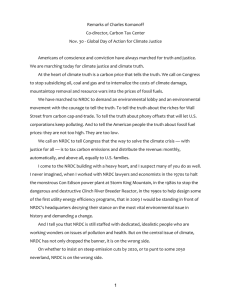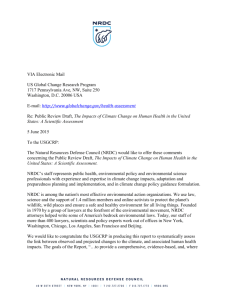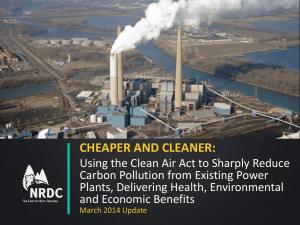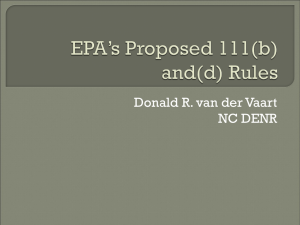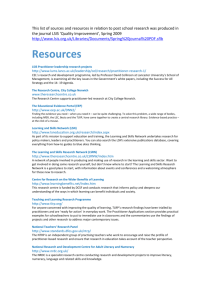impacts of system based approach
advertisement
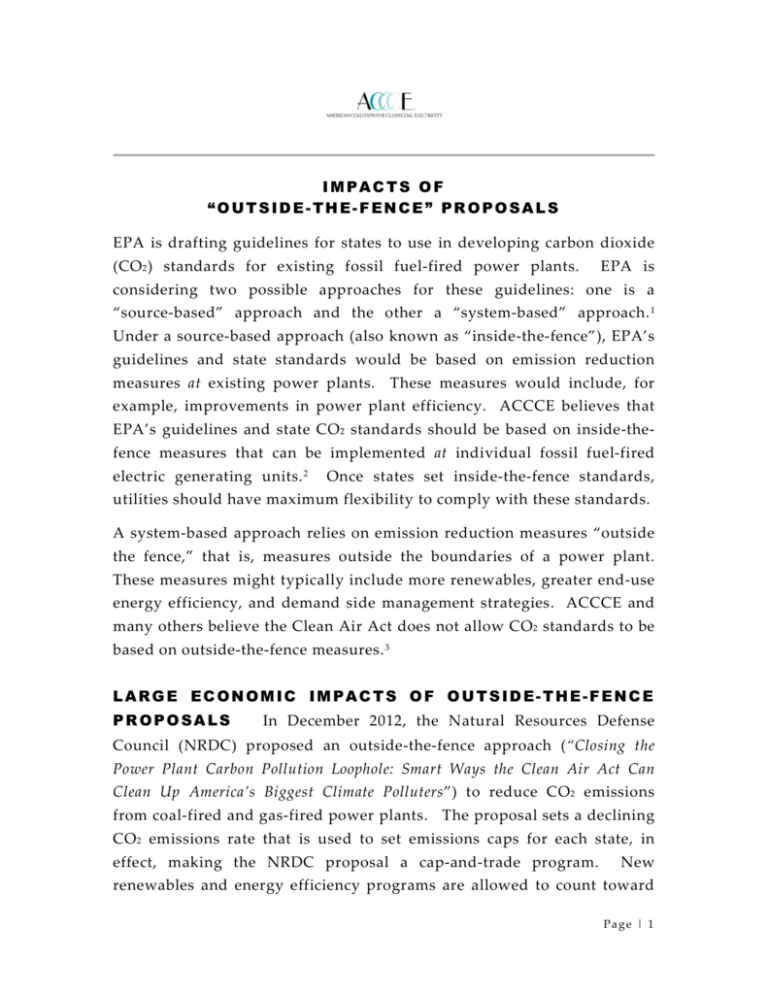
IMPACTS OF “OUTSIDE-THE-FENCE” PROPOSALS EPA is drafting guidelines for states to use in developing carbon dioxide (CO 2 ) standards for existing fossil fuel-fired power plants. EPA is considering two possible approaches for these guidelines: one is a “source-based” approach and the other a “system-based” approach. 1 Under a source-based approach (also known as “inside-the-fence”), EPA’s guidelines and state standards would be based on emission reduction measures at existing power plants. These measures would include, for example, improvements in power plant efficiency. ACCCE believes that EPA’s guidelines and state CO 2 standards should be based on inside-thefence measures that can be implemented at individual fossil fuel-fired electric generating units. 2 Once states set inside-the-fence standards, utilities should have maximum flexibility to comply with these standards. A system-based approach relies on emission reduction measures “outside the fence,” that is, measures outside the boundaries of a power plant. These measures might typically include more renewables, greater end-use energy efficiency, and demand side management strategies. ACCCE and many others believe the Clean Air Act does not allow CO 2 standards to be based on outside-the-fence measures. 3 LARGE ECONOMIC IMPACTS OF OUTSIDE-THE-FENCE PROPOSALS In December 2012, the Natural Resources Defense Council (NRDC) proposed an outside-the-fence approach (“Closing the Power Plant Carbon Pollution Loophole: Smart Ways the Clean Air Act Can Clean Up America’s Biggest Climate Polluters”) to reduce CO 2 emissions from coal-fired and gas-fired power plants. The proposal sets a declining CO 2 emissions rate that is used to set emissions caps for each state, in effect, making the NRDC proposal a cap-and-trade program. New renewables and energy efficiency programs are allowed to count toward Page | 1 compliance. Earlier this week, NRDC updated the analysis of their proposal. NERA Economic Consulting (NERA) was retained by ACCCE to conduct an independent analysis of the 2012 NRDC proposal. NERA analyzed two scenarios to approximate an upper and lower limit to the potential impacts of the outside-the-fence proposal. 4 Some of the impacts are as follows: NERA projects the NRDC proposal would cost consumers $13 billion to $17 billion per year. By comparison, NRDC’s 2012 analysis projected electric sector compliance costs of $4 billion in 2020, while the updated analysis projects no costs at all in 2020. NERA’s analysis includes increased costs for natural gas for non-electric consumers; NRDC did not report increased costs for natural gas consumers. NERA projects total consumer costs would be $116 billion to $151 billion during 2018-2033 (the period modeled by NERA). NRDC did not provide total costs. NERA projects net job losses totaling as many as 2.85 million over the 20182033 period. By comparison, NRDC projected net job gains of 76,000 jobs in 2016 and 210,000 in 2020, the only two years for which NRDC provided employment impacts. 5 NERA projects retail electricity prices would increase by double digit percentages in as many as 29 states. NRDC projects that nationwide average wholesale electricity prices would decrease. NERA projects additional coal retirements would total between 35,000 megawatts (MW) and 83,000 MW. Total retirements, including those due to other EPA regulations, would total 76,000 MW to 124,000 MW and represent approximately 25 percent to 40 percent, respectively, of the entire U.S. coal fleet. NRDC projected additional coal retirements of 59,000 MW. Natural gas-fired generation would increase by 8 percent to percent. NRDC projected only a 2 percent increase. Page | 2 61 Natural gas prices would increase by as much as 16 percent, according to NERA. Consumers outside the electric sector would pay as much as $54 billion more for natural gas over the period 2018 – 2033. NRDC projected very little change in natural gas prices by 2020 and did not provide a total cost of natural gas for consumers. NERA’s report, “A Carbon Dioxide Standard for Existing Power Plants: Impacts of the NRDC Proposal,” provides additional information on the scenarios, assumptions, and other impacts. The Clean Air Task Force (CATF) also proposed an outside-the-fence program in February 2014. 6 CATF projected that its proposal, based largely on substituting natural gas for coal, would cost $9.4 billion in 2020. ACCCE has not conducted an independent analysis of the CATF proposal, but its impacts are consistent with the results of NERA’s analysis of NRDC’s outside-the-fence proposal. NEGLIGIBLE BENEFITS The U.S. coal fleet represents only 3 percent of global man-made greenhouse gas emissions. Completely eliminating all U.S. coal plants, for example, would reduce sea level rise by less than the thickness of a dime and reduce average global temperature increase by 0.05 degree F by 2050. 7 In light of these negligible benefits as well as the requirements of the Clean Air Act, EPA’s guidelines and state CO2 standards should be based on inside-the-fence -- not outside-the-fence -- measures. March 21, 2014 1 U.S. EPA, Considerations in the Design of a Program to Reduce Carbon Pollution from Existing Power Plants, September 2013. http://www2.epa.gov/sites/production/files/201309/documents/20130923statequestions.pdf. 2 42 U.S.C. §7411(d) and (a)(1). 3 See, for example, Establishment of Standards of Performance for Carbon Dioxide Emissions from Existing Electric Utility Generating Units under Clean Air Act §111(d), Hunton and Williams for the Utility Air Regulatory Group, April, 2013; and North Carolina §111(d) Principles, North Carolina Department of Environment and Natural Resources, January 2014. 4 The two cases are “Maximum Flexibility” and “Limited Flexibility.” The Maximum Flexibility case assumes nationwide trading and allows new renewables and end-use energy efficiency to count toward compliance. The Limited Flexibility case assumes each state must meet its emissions rate target without Page | 3 interstate trading and new renewables and energy efficiency cannot be used for compliance. We believe the Limited Flexibility scenario is more likely to approximate the impacts of a system-based approach, primarily because EPA’s schedule does not allow time for states to maximize compliance flexibility. 5 NRDC Issue Brief: Less Carbon, More Jobs, Lower Bills: Protecting future generations from climate change, starting with power plants, July 2013, citing Economic Impacts of the NRDC Carbon Standard, Synapse Energy Economics, Inc., June 20, 2013. 6 Clean Air Task Force, Power Switch: An Effective, Affordable Approach to Reducing Carbon Pollution from Existing Fossil-Fueled Power Plants, February 2014. 7 ACCCE, Climate Effects of Carbon Regulations for the U.S. Coal Fleet, September 2013. Page | 4
